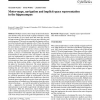Free Online Productivity Tools
i2Speak
i2Symbol
i2OCR
iTex2Img
iWeb2Print
iWeb2Shot
i2Type
iPdf2Split
iPdf2Merge
i2Bopomofo
i2Arabic
i2Style
i2Image
i2PDF
iLatex2Rtf
Sci2ools
BC
2006
2006
Motor-maps, navigation and implicit space representation in the hippocampus
Abstract Multiple sensory-motor maps located in the brainstem and the cortex are involved in spatial orientation. Guiding movements of eyes, head, neck and arms they provide an approximately linear relation between target distance and motor response. This involves especially the superior colliculus in the brainstem and the parietal cortex. There, the natural frame of reference follows from the retinal representation of the environment. A model of navigation is presented that is based on the modulation of activity in those sensory-motor maps. The actual mechanism chosen was gain-field modulation, a process of multimodal integration that has been demonstrated in the parietal cortex and superior colliculus, and was implemented as attraction to visual cues (colour). Dependent on the metric of the sensory-motor map, the relative attraction to these cues implemented as gain field modulation and their position define a fixed point attractor on the plane for locomotive behaviour. The actual im...
| Added | 10 Dec 2010 |
| Updated | 10 Dec 2010 |
| Type | Journal |
| Year | 2006 |
| Where | BC |
| Authors | Alexander Kaske, Gösta Winberg, Joakim Cöster |
Comments (0)

